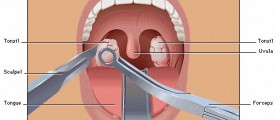Tonsillectomy
This surgery is associated with the removal of the tonsils and there are the some complications that can arise after the surgery. They will be the focus of this text. It is important to know that there are ways of minimizing their effect. The tonsils are the organs that are responsible for the antibodies production, they consist of the lymphatic tissue pads, and they eliminate infections through the nose and mouth.
Inflammations can easily attack the tonsils, which can lead to the enlargement or the mentioned inflammation of the tonsils. This problem has the name of tonsillitis and creates upper airway obstruction, bad breath and sore throat. Surgery is the only solution if the problem becomes so great that it cannot be treated with medications. Tonsillectomy is the surgery that accomplishes this.

Complications
There are some complications involved with tonsillectomy, which is usually done due to the narrowing of the breathing passages caused by the enlarged tonsils. Some patient even experience chocking, but the problem may cause damage to the lungs and heart, if it is not treated. Almost all surgeries involve infection, anesthesia and bleeding as complications. The doctor will see if you are a candidate for the surgery.
- Retrospective cohort study of 5968 adult patients who underwent tonsillectomy with records in the database of the American College of Surgeons National Surgical Quality Improvement Program (2005 to 2011).
- The 30-day mortality rate was 0.03%, the complication rate was 1.2%, and the reoperation rate was 3.2%. Most patients had a primary diagnosis of chronic tonsillitis and/or adenoiditis (82.9%), and the most common complications were pneumonia (27% of all complications), urinary tract infection (27%), and superficial site infections (16%).
- Patients who underwent reoperation were more likely to be male (54.0% vs 32.4%; P?.001), white (84.8% vs 75.3%; P?=?.02), or inpatients (24.3% vs 14.3%; P?.001) and to have postoperative complications (5.3% vs 1.1%; P?.001) than those who did not return to the operating room. On multivariate analysis, male sex, inpatient status, and the presence of a postoperative complication were independent risk factors for reoperation.
- A recent survey of 552 otolaryngologists determined an extrapolated mortality rate of 1 in 27?000, or 0.004%. Prior European studies have reported mortality rates after adult and pediatric tonsillectomy ranging from 1 in 10?000 to 1 in 33?921. Our study confirms, on a population level, that adult tonsillectomy in the United States is a safe procedure with a low mortality rate.
- We determined that the overall rate of substantial bleeding in our cohort was 0.08%. A recent analysis of 361 adult patients demonstrated a 5% rate of postoperative hemorrhage. In studies looking at both adult and pediatric patients, rates of postoperative bleeding range from 1.5% to 15%. Our rate of substantial bleeding only captured postoperative bleeding requiring transfusion of more than 4 units of PRBCs, so the total postoperative bleeding rate in our cohort was likely closer to the reoperation rate of 3.2%.
As we have mentioned, anesthesia is one of the complications. There are several problems that it can be caused and some of them are lung infection, stroke, heart attack or confusion. Next possible complication is bleeding, which is not very common, but it can happen. When it happens, the blood transfusion has to be done. There are cases when the bleeding does not happen during, but after the surgery, when the patient comes home and this bleeding should not last more than 4 to 8 days. Children frequently experience bleeding problems after the surgery. After the tonsillectomy, every fifth child experiences this problem.
An infection is another complication, and it can be mild or severe. Mild infections are common and they require no serious treatment, while more severe ones need antibiotics. Some pain may be experienced as well, but this pain is not evident right after the surgery, but two or three weeks later. Painkillers are given for this problem, which requires hospital visit if it is persistent.
There are some long-term complications after the tonsillectomy, such as laryngitis, nasal allergies, sinusitis, upper respiratory tract infection and chest infection. If you do this surgery, bad breath problem is eliminated and swallowing is made more easily. There are complications that may arise after the surgery, so it best to do everything the doctor tells you to in order to avoid them. Try to exercise, avoid smoking, citrus, sticky and spicy food.

















Your thoughts on this
Loading...